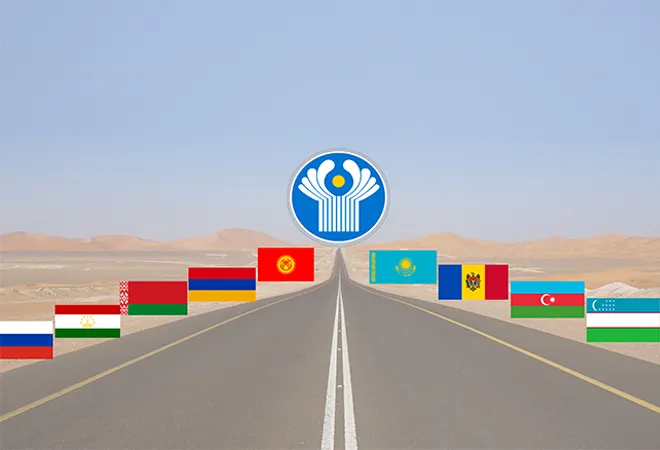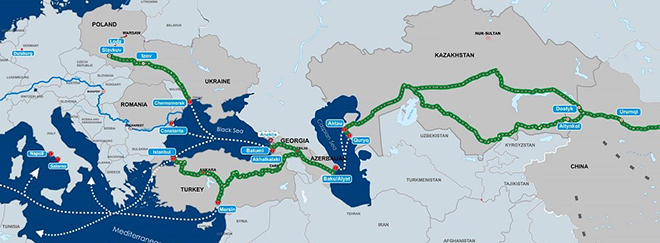
The recent announcement of the Russian President Vladimir Putin
to build a railway line connecting Iran along the North-South Trade Corridor (NSTC)—a corridor that connects India to Russia via Iran and Azerbaijan—was a welcoming development for India’s foreign trade policy in the Eurasian region. The entanglement of the trade corridors in the Eurasian region challenges the development status quo of competing interests that mainly include the rising China’s Middle Corridor (Figure 1) and the declining China’s Northern Corridor (China to Europe via Russia) against the NSTC.
Figure 1: The middle corridor transit trade route s through the Central Asian steppe, the Caspian Sea, and the Caucasus Mountains. Reference:
www.top-center.org

The Middle Corridor was undermined until recently in the Eurasian geoeconomics where multimodal transit—roadways, railways, and shipping—was considered inefficient in comparison to China’s Northern Corridor. Since the Russia-Ukraine conflict, the cargo traffic
has grown to nearly 3.2 million tons in the Middle Corridor in 2022, mostly shifting from the Northern Corridor. The countries involved in the Middle Corridor transit are also strengthening their connectivity through normalising standards of customs and integrating cargo, along with the development of various ports including Aktau Seaports (Kazakhstan, Eastern Caspian Sea), Alyat Seaports (Azerbaijan, Western Caspian Sea), Fuzuli and Zangilan Airport (Azerbaijan), and the expansion of cargo fleets with Baku shipbuilding.
The Middle Corridor was undermined until recently in the Eurasian geoeconomics where multimodal transit—roadways, railways, and shipping—was considered inefficient in comparison to China’s Northern Corridor.
With such dynamic changes taking place in the Middle Corridor, it could define the geoeconomics of the Eurasian region. This could bind the Central Asian and Chinese economies with the European markets. But in an alternate scenario, this binding could be averted, if there is some presence of viable alternatives for the Central Asian countries. One such viable alternative could be the international NSTC, which circumvents both, the Western sphere of influence and the Chinese BRI debt-trap diplomacy. Azerbaijan stands at the crossroads of the competing transit corridors, and it will have to manage Chinese global geoeconomic aspirations and geopolitical implications for the countries involved in the trade corridors.
Türkiye geoeconomic interest
Türkiye aspires to make itself indispensable with both Chinese and European power blocs, and along with it create its regional influence using its soft power with the
‘Organization of Turkish states’. The Middle Corridor provides the shortest route from China to Europe crossing the Eurasian region, which saw a
sixfold rise in cargo transportation in the last decade, bolstering Türkiye ’s ambitions to become a leader in container freight.
The Middle Corridor is projected to increase the capacity across the transit from 6 million to 50 million tons, adding to the Chinese vision of the ‘Iron Silk Road’ alongside the growing Turkish regional influence. With this, Türkiye is also playing a critical role as a facilitator of the European value chain due to its geographical construct, leaving the
European Union with a bipolar nature. Alternatively, a perspective could be that the multiple Central Asian countries are managing their economic growth with Europe through China’s ‘
Westward March’. Recent leader's meetings at the
C+C5 Summit built stronger congruence and consensus amongst all the stakeholders.
The Middle Corridor is projected to increase the capacity across the transit from 6 million to 50 million tons, adding to the Chinese vision of the ‘Iron Silk Road’ alongside the growing Turkish regional influence.
Türkiye aims to
become a top Mediterranean outlet by investing
US$ 0.38 billion in Mersin,
US$0.15 billion in Filyos, and
US$1.2 billion in Izmir in port infrastructure, in addition to the
Chinese company owning two-thirds of the Kumport terminal. With China’s aid
, Türkiye has built Yavuz Sultan Selem Bridge and Marmaray Tunnel, which reduces transit time via the maritime route from two months to two weeks along the Middle Corridor. In addition, the European powers are receiving critical gas supplies amidst the energy crisis in the region through the ‘
Southern Gas Corridor’, starting from the Caspian Sea in Baku and through Türkiye, which is projected to double its capacity by 2027 as per its promise to Brussels. This is in addition to the underwater
‘Black Sea Electric Cable’ to share the wind and solar energy from the Caspian Sea through Azerbaijan.
Azerbaijan at a crossroads
A railway route via Azerbaijan is the only land transit route that connects China and Central Asia to Europe without the involvement of the pariah states of Iran and Russia. The Chinese trade corridor reaching Europe via Russia will be a lost battle in this decade due to the Russia-Ukraine conflict and the maritime route reaching Europe via the Malacca Strait remains a high geopolitical and value chain risk. Whereas for China, the Middle Corridor is less prone to disruptions as it bypasses states like Afghanistan, Russia, and Iran, and choke points like the Malacca Strait.
A free trade agreement was finalised between the Eurasian Economic Union (EEU) with Iran, which will accelerate their bilateral relations and the transit route once the deal will come into force.
Another passage via Baku is the North-South Trade Corridor (NSTC) which also resonates with
India’s participation in the Ashgabat Agreement of multimodal transport in the region. It gives India access to the Persian Gulf and the Central Asian markets with several infrastructure projects in the region. The NSTC reduces time and costs over traditional value chain connectivity, eventually improving the bilateral relations amongst the member countries involved in the transit. Another critical member of the NSTC is Iran which
has tense relationships with its neighbour Azerbaijan. Thus, engaging with more neutral states in the NSTC transit route will allow more trade diversification without aligning with any power blocs. In January 2023,
a free trade agreement was finalised between the Eurasian Economic Union (EEU) with Iran, which will accelerate their bilateral relations and the transit route once the deal will come into force. Similarly, a possible
Russia-India Free Trade Agreement would accelerate such routes for ‘friends with mutual interests’.
Conclusion
It is evident that the BRI development efforts are now surviving because of the Middle Corridor, which is divergent from the strategic and diplomatic goals of the C+C5 regional countries. In addition, the Middle Corridor also has other complications: Turkmenbashi port is underdeveloped, high tariffs in the transit in Turkmenistan; Kyrgyzstan’s political scepticism; regional tensions between Azerbaijan and Armenia (affecting the Zangezur corridor); and Türkiye's emphasis on Turkish integration could fuel separatist behaviour of Uighur minorities in China. Subsequently, the multimodal transit vision of the Middle Corridor is lacking in the construction of a railway across the Caspian Sea, as Russia and Iran hold the veto rights for the development projects in the Caspian Sea. The countering route of NSTC, where the parts of the infrastructure were underdeveloped, is now underway with the recent announcement of Russia and Iran developing efficient functioning of the NSTC. This will align with the broader vision of the NSTC transit corridor and further showcase its economic potential, consequently helping India to produce a viable transit solution in the region.
Sagar K. Chourasia, Associate Fellow, Centre for Economy, and Growth at ORF
The views expressed above belong to the author(s). ORF research and analyses now available on Telegram! Click here to access our curated content — blogs, longforms and interviews.



 The recent announcement of the Russian President Vladimir Putin
The recent announcement of the Russian President Vladimir Putin 
 PREV
PREV


